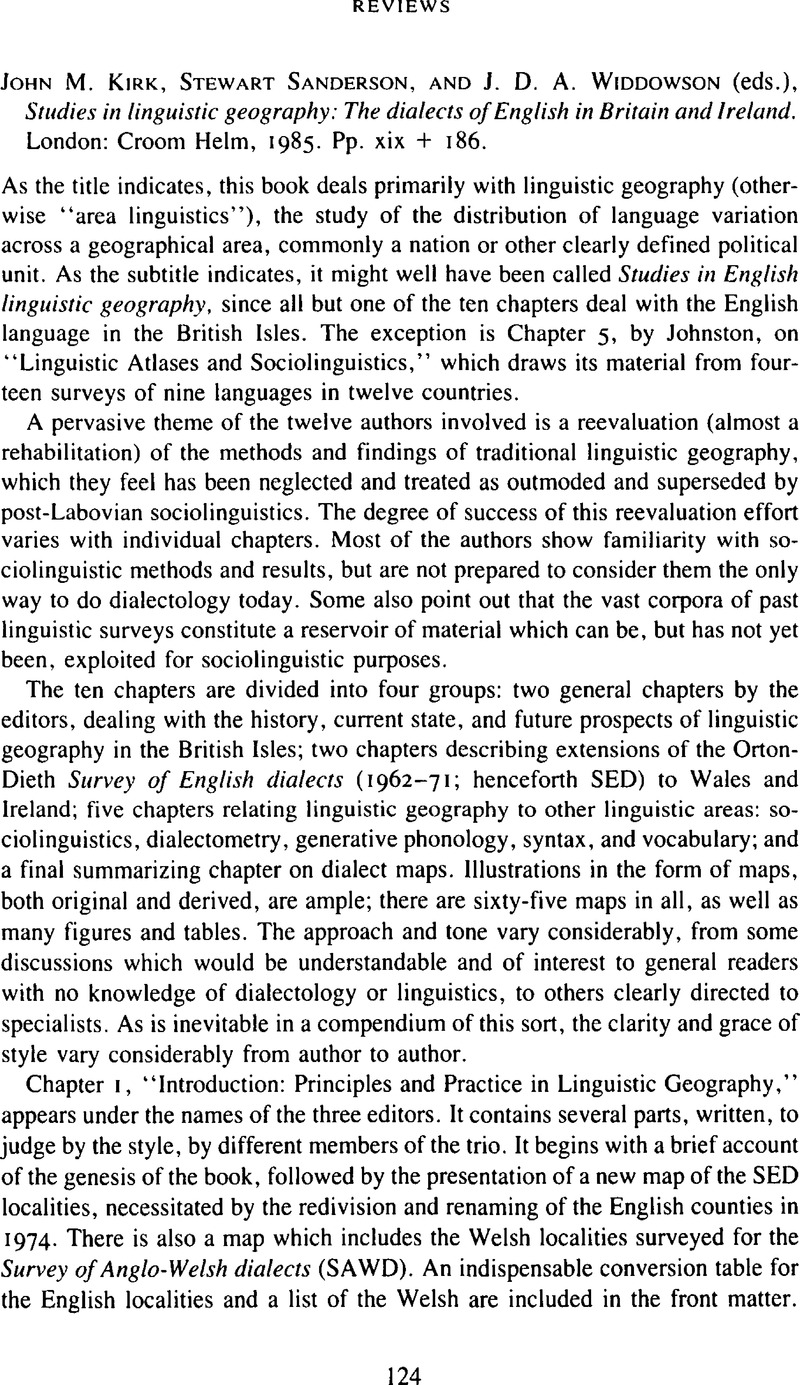No CrossRef data available.
Article contents
John M. Kirk, Stewart Sanderson, and J. D. A. Widdowson (eds.), Studies in linguistic geography: The dialects of English in Britain and Ireland. London: Croom Helm, 1985. Pp. xix + 186.
Published online by Cambridge University Press: 18 December 2008
Abstract
An abstract is not available for this content so a preview has been provided. Please use the Get access link above for information on how to access this content.

- Type
- Book Review
- Information
- Copyright
- Copyright © Cambridge University Press 1988
References
REFERENCES
Brown, G. (1972). Phonological rules and dialect variation: A study of the phonology of Lumasaaba. (Cambridge Studies in Linguistics, 7.) Cambridge: Cambridge University Press.Google Scholar
Cheshire, J. (1982). Variation in an English dialect: A sociolinguistic study. (Cambridge Studies in Linguistics, 37.) Cambridge: Cambridge University Press.Google Scholar
Edwards, V., Trudgill, P., & Weltens, B. (1984). The grammar of English dialect. London: Economic and Social Research Council.Google Scholar
Francis, W. N. (1970). Modal daren't and durstn't in dialectal English. In Ellis, S. (ed.), Studies in honour of Harold Orton on the occasion of his seventieth birthday. (Leeds Studies in English, n.s. 2.) Leeds: School of English, University of Leeds. 145–63.Google Scholar
Francis, W. N. (1983). Dialectology: An introduction. (Longman Linguistics Library, 29.) London: Longman.Google Scholar
Francis, W. N. (1985). Amn't I or The hole in the pattern. In Viereck, W. (ed.). Focus: On England and Wales. Amsterdam: John Benjamins. 141–52.Google Scholar
Francis, W. N., Svartvik, J., & Rubin, G. M. (1969). Computer-produced representation of dialectal variation: Initial fricatives in Southern British English. Preprint No. 52, COLING, Stockholm.CrossRefGoogle Scholar
Goossens, J. (1969). Strukturelle Sprachgeographie: ein Einführung in Melhodik und Ergebnisse. Heidelberg: Carl Winter Universitätsverlag.Google Scholar
Grice, H. P. (1975). Logic and conversation. In Cole, P. & Morgan, J. L. (eds.). Syntax and semantics, vol. 3: Speech acts. New York: Academic. 41–58.Google Scholar
Kolb, E., Glauser, B., Elmer, W., & Stamm, R. (1979). Atlas of English sounds. Bern: Francke Verlag.Google Scholar
Mather, J. Y., & Speitel, H. H. (eds.) (1975–1977). The linguistic atlas of Scotland. Scots section. 2 vols. London: Croom Helm.Google Scholar
Newton, B. (1972). The generative interpretation of dialect: A study of Modern Greek phonology. (Cambridge Studies in Linguistics, 8.) Cambridge: Cambridge University Press.Google Scholar
Orton, H. et al. (eds.) (1962–1971). Survey of English dialects. Introduction and 4 volumes in 12 parts. Leeds: E. J. Arnold & Son Ltd. for the University of Leeds.Google Scholar
Orton, H., Sanderson, S., & Widdowson, J. (eds.) (1978). The linguistic Atlas of England. London: Croom Helm.Google Scholar
Parry, D. (ed.) (1977–1980). The survey of Anglo-Welsh dialects. 2 vols. Swansea: privately published.Google Scholar
Putschke, W. (1983). Sprachgeographie: Irrtum oder Forschungsinstrument? In Mattheier, K. J. (ed.), Aspekte der Dialekttheorie. Tübingen: Max Niemeyer Verlag. 83–103.Google Scholar
Seéguy, J. (1973). La dialectométrie dans L'Atlas linguistique de la Gascogne. Revue de linguistique romane 37:1–24.Google Scholar
Troike, R. C. (1971). Overall pattern and generative phonology. In Allen, H. B. & Underwood, G. N. (eds.), Readings in American dialectology. New York: Appleton-Century-Crofts. 324–42.Google Scholar
Trudgill, P. (1983). Sociolinguistics and dialectology. In On dialect: Social and geographical perspectives. Oxford: Blackwell. 38–44.Google Scholar


